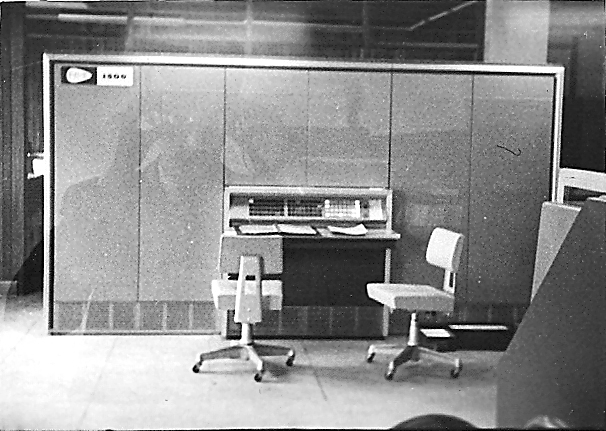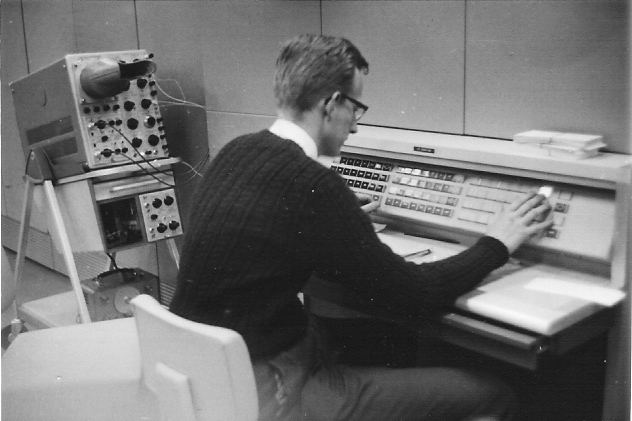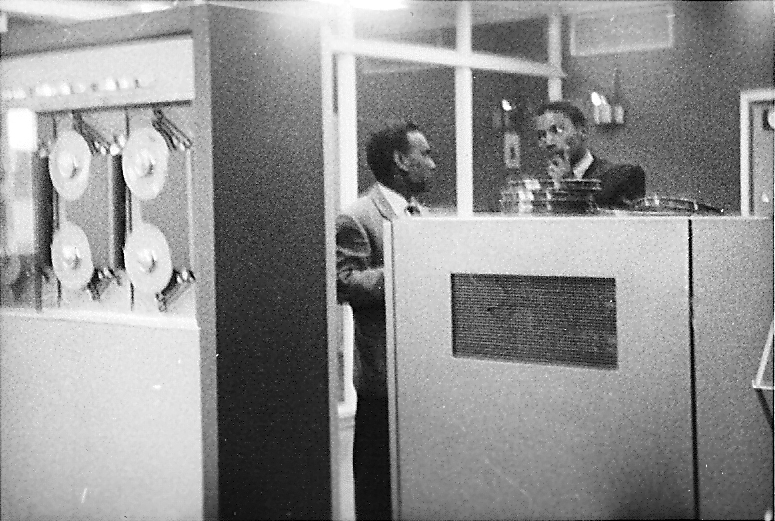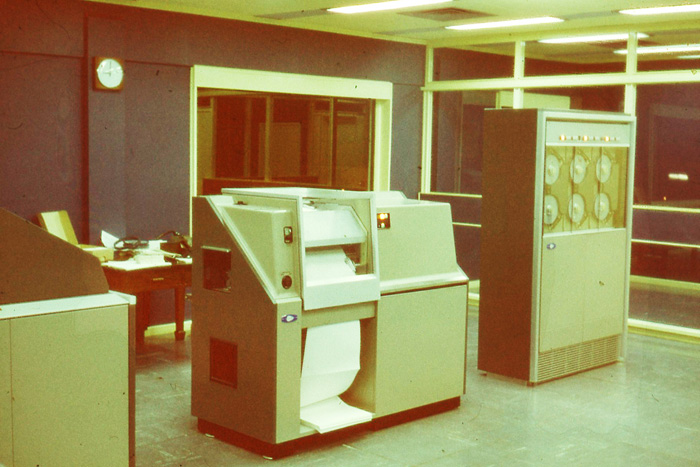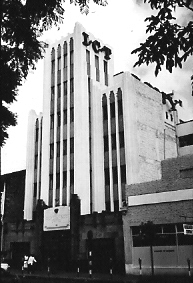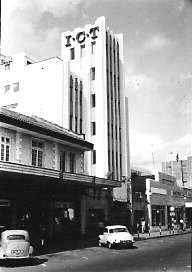Early Computers In Kenya
As independence approached for Kenya in the mid 1960's, some extra funds became available to help with the transition of the Government administration to complete local control. Two beneficiaries of this were the East African Railways & Harbours (EAR&H) which could now upgrade its 1202 HEC machine to an ICT 1500, and East African Power & Light (EAP&L) which also got an ICT 1500 to transition it from a conventional Hollerith site with Tabulators, Sorters, Collators, Calculatos and Summary Punches.
The ICT 1500 at EAR&H
Around 1964 the original 1202 at EAR&H was replaced by a more modern ICT 1500. This was a re-badged version of the American-built RCA 301. This machine was almost all solid-state (transistorized) and this particular unit had a central memory of 20,000 6-bit characters. It had 6 tape units and a printer made by Anelex that could operate at 1000 lines/minute. It also had card-reader built by RCA that could operate at 1000 cards/minute as well as a card punch built by ICT that could operate at 100 cards/minute. Programming was done either in FAS (Fifteen-Hundred Assembler Code) or Cobol. The assembler and compiler operated from overlays held on tape, there was no operating system as we know it today. A minimal Cobol compilation took about 90 minutes to achieve, compiling a real production program would take between 2 and 3 hours. Thus it was usual to save the binaries once a program had been compiled successfully, and then debug/correct the binary from then on via octal corrections applied directly to the object program.
The ICT 1500 at EAP&L
At about the same time as the ICT 1500 was installed at EAR&H, a similar machine was installed at East African Power & Light (EAP&L) This was a "shared" machine, used during the day-shift by EAP&L for electricity billing, and during night-shift as a Service Bureau (Data Center) by ICT(EA) for others of their customers. The first of these was the Post Office Savings Bank (maintaining accounting records of savings accounts) and the Kenya Tea Development Authority (KTDA) for generating payments to small-holder tea farmers.
The console was divided into three banks of lights/buttons. On the left were error indicator lights, in the center were buttons with which to select what was to be displayed (memory address or status codes) and the display was shown on the right-hand part. The latter were buttons with lights, so that the operator could for example bring up the contents of a memory word (in binary) and then modify it via the buttons and cause the new value to be stored in a selected memory location.
On the shelf over the console can be seen two decks of cards. These were the "loader" and a spare backup copy in case a card got mangled. To initiate the running of a program, the operator would first insert a very short boot sequence into memory from the console. This boot sequence was just enough to cause a single card to be read into memory containing a further set of seven instructions and a "jump" into these instructions. The latter then caused a second card to be read with more instructions and so on until the whole loader had been loaded. This was then used to load whatever production program was desired.
In this picture we can see the tape-units of the EAP&L machine on the left. There were six individual units, three on each side of the cabinet located behind sliding glass doors. The tapes operated at a transfer rate of 10,000 characters/sec and the acceleration/deceleration of the reels was managed by means of mechanical servo arms through which the tape was "serpentined". Depending on how much slack tape existed between a reel and the read/write capstans, so the servo arms would swing in or out - in turn signaling the reel motors to speed up or slow down. To the right we can see the back of the Anelex printer with some tape reels stacked on top of it.
This picture shows the same scene from the other side. This is the front of the Anelex printer which printed on "Fanfold" paper up to 18" wide and 136 characters on a line. It was a drum printer, the drum had the characters A-Z and 0-9 arranged around its circumference 136 times. The drum spun continuously at 1000 r.p.m. and 136 separate hammers (solenoid activated) smacked the ribbon against the paper as the corect character came round in each column position. If due to program error, you clobbered the print table in memory, causing print hammers to try and strike more than once per revolution, you'd blow the fuse for that print hammer. Since clobbering the print table caused this to happen for all columns, you'd actualy blow 136 fuses in one shot, which took quite a while to replace - during which time the machine was down.
To the right we can see the three tape units on the other side of the tape cabinet - this was before tape reels became standardised at 10.5" diameter with a 3.5" hub, holding 2400 ft. of 1/2 inch tape.
The ICT Headquarters in Nairobi
Originally the headquarters for ICT (East Africa) were on the second floor above the show-room of the Boero car dealership, and directly across the street from The Donovan Maule Theater. (Boero was the supplier of FIAT motor cars in Nairobi). The HQ consisted of some offices as well as a punched-card Service Bureau that provided services for customers using conventional punched-card tabulating equipment. After Boero vacated the premises, the Data Center was moved downstairs into the former showroom, and the offices were moved to the top few floors of "The Gilfillan Building" seen above.
Postscript
ICT (East Africa) covered not only Kenya (where most of its installations were) but also Uganda and what was then called Tanganyika.
The main (only?) site in Uganda was the Uganda Electricity Board (UEB) which started out with conventional Hollerith punched-card equipment but was upgraded to an ICT 1004 around independence. The latter machine was merely a re-badged Univac 1004 and not really a computer so much as a electronically programmable tabulator (unlike the older Hollerith tabulators which were electro-mechanical). It was also faster and more flexible in that it could be programmed to multiply/divide, and make more complex decisions whereas the older tabulators were limited to addition/subtraction and only rudimentary decision making based on the presence/absence of holes in a punched card. This machine "disappeared" amidst the chaos of the Idi Amin regime.
The main (only?) site in Tanganyika was Customs and Excise who too were upgraded from conventional Hollerith Tabulators to an ICT 1500 around the time of Independence. However, soon after independence for Tanganyika, unrest hit that country (army mutiny, attempted coup and so forth) which culminated in a major paroxysm whereby Tanganyika federated with Zanzibar to become what we know today as Tanzania. During this time the 1500 at Customs and Excise also "disappeared" and was alleged to have been taken by the Chinese (who were "helping" the new Government on a number of matters) and exported back to China.
Other important ICT installations in Kenya were East African Airways and the Post Office Savings Bank - however both of these sites used Powers-Samas equipment (40-column cards with round holes, and primarily mechanical rather than electro-mechanical tabulators, sorters and collators)
